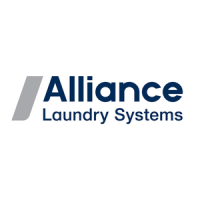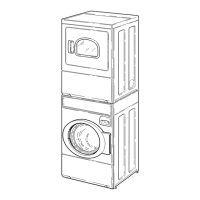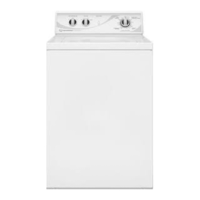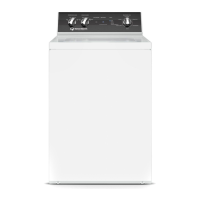
Do you have a question about the Alliance Laundry Systems Washer-Extractor and is the answer not in the manual?
| Brand | Alliance Laundry Systems |
|---|---|
| Model | Washer-Extractor |
| Category | Washer |
| Language | English |
Explains the meaning of DANGER, WARNING, CAUTION, IMPORTANT, and NOTE statements used in the manual.
Lists essential safety precautions to reduce the risk of fire, electric shock, and injury when operating the washer.
Lists all applicable models and provides a guide to understanding model number prefixes and components.
Provides instructions for visually inspecting the unit for shipping damage upon delivery and reporting any issues.
Identifies the location of the machine's nameplate for model and serial number reference when ordering parts.
Explains how to interpret the model number by breaking down its components and their meanings.
Provides contact information for ordering replacement parts and finding authorized distributors.
Provides contact information for technical assistance and customer support.
Lists the overall width, height, and depth of the washer-extractor models in inches and millimeters.
Details net weight, shipping weight, and shipping volume for various models in pounds and cubic feet.
Provides specifications for the wash cylinder, including diameter, depth, and volume in inches and cubic feet.
Specifies the diameter of the door opening and the height of the door bottom above the floor.
Details the average power used per cycle and the average HVAC load for different models.
Lists the number of motors and power ratings for the drive train of various washer-extractor models.
Indicates if a vibration switch is installed for balance detection on different washer models.
Lists steam inlet connection size, number of inlets, and steam requirements for heating.
Specifies switch gap settings for vibration switches and the procedure to check and adjust them.
Lists detailed dimensions (A through S) for various machine capacities in inches and millimeters.
Lists detailed dimensions (A through T) specific to 125-pound capacity models in inches and millimeters.
Provides required clearances (A through F) around the machine for proper installation.
Details requirements for the machine foundation, including floor type, strength, and leveling.
Specifies foundation thickness, installation methods, and anchoring bolt requirements by model.
Presents static and dynamic floor load data for 2-speed models by capacity.
Presents static and dynamic floor load data for variable-speed models by capacity.
Outlines the process and requirements for anchoring the machine to the floor.
Details the steps for installing the machine directly onto a finished floor using expansion bolts.
Describes the procedure for installing the machine using J-bolts, including hole preparation.
Instructs to reset the balance switch to the correct gap setting after mounting.
Lists part numbers for metal templates used for marking mounting hole locations without an elevated base frame.
Shows diagrams and dimensions for mounting bolt hole locations for 18-20, 25, 27-30, and 50 pound models.
Shows diagrams and dimensions for mounting bolt hole locations for 35, 40, 60, 80, and 125 pound models.
Shows diagrams and dimensions for mounting bolt hole locations when using elevated base frames for 18-20, 25, and 35 pound models.
Shows diagrams and dimensions for mounting bolt hole locations when using elevated base frames for 40, 50, and 60 pound models.
Details the installation process for factory-built elevated steel base frames.
Explains how to position and secure the elevated base frame using templates and J-bolts.
Outlines how to construct a concrete foundation pad to elevate machines.
Illustrates typical drain trough and drain line installations and connection requirements.
Provides capacity-specific drain information, including connection size and drain flow capacity.
Details minimum drain line sizing requirements based on the number of machines.
Specifies water supply line sizing and connection procedures for hot and cold water.
Covers important warnings and requirements for electrical connections, including voltage and wiring.
Discusses requirements for input voltage and contact with power companies.
Specifies the types of circuit breakers required for different machine models.
Provides guidance on making electrical connections, wire sizes, and grounding.
Details safety requirements and methods for properly grounding the machine.
Explains the use of a phase adder for 2-speed models when three-phase service is unavailable.
Presents detailed electrical specifications for 18 and 20 pound capacity models.
Provides steps to troubleshoot machine operation issues, focusing on power and circuit fuses.
Details steam requirements, including inlet connection size and pressure, for models with steam heat.
Describes supply dispensing features and precautions for OPL machines.
Explains how to connect external liquid supply hoses and nozzles for OPL models.
Outlines the procedure for performing a function test on the machine after installation.












